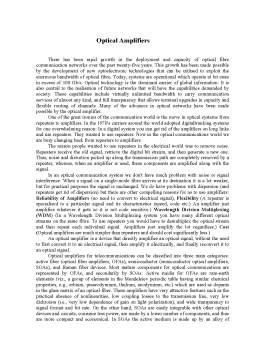Extras din referat
Optical Amplifiers
There has been rapid growth in the deployment and capacity of optical fibre communication networks over the past twenty-five years. This growth has been made possible by the development of new optoelectronic technologies that can be utilised to exploit the enormous bandwidth of optical fibre. Today, systems are operational which operate at bit rates in excess of 100 Gb/s. Optical technology is the dominant carrier of global information. It is also central to the realisation of future networks that will have the capabilities demanded by society. These capabilities include virtually unlimited bandwidth to carry communication services of almost any kind, and full transparency that allows terminal upgrades in capacity and flexible routing of channels. Many of the advances in optical networks have been made possible by the optical amplifier.
One of the great ironies of the communication world is the move in optical systems from repeaters to amplifiers. In the 1970's carriers around the world adopted digitaltrunking systems for one overwhelming reason: In a digital system you can get rid of the amplifiers on long links and use repeaters. They wanted to use repeaters. Now in the optical communications world we are busy changing back from repeaters to amplifiers.
The reason people wanted to use repeaters in the electrical world was to remove noise. Repeaters receive the old signal, retrieve the digital bit stream, and then generate a new one. Thus, noise and distortion picked up along the transmission path are completely removed by a repeater, whereas, when an amplifier is used, these components are amplified along with the signal.
In an optical communication system we don't have much problem with noise or signal interference. When a signal on a single-mode fibre arrives at its destination it is a lot weaker, but for practical purposes the signal is unchanged. We do have problems with dispersion (and repeaters get rid of dispersion) but there are other compelling reasons for us to use amplifiers: Reliability of Amplifiers (no need to convert to electrical signal), Flexibility (A repeater is specialised to a particular signal and its characteristics (speed, code etc.) An amplifier just amplifies whatever it gets so it is not code sensitive.) Wavelength Division Multiplexing (WDM) (In a Wavelength Division Multiplexing system you have many different optical streams on the same fibre. To use repeaters you would have to demultiplex the optical stream and then repeat each individual signal. Amplifiers just amplify the lot regardless.) Cost (Optical amplifiers are much simpler than repeaters and should cost significantly less.)
An optical amplifier is a device that directly amplifies an optical signal, without the need to first convert it to an electrical signal, then amplify it electrically, and finally reconvert it to an optical signal.
Optical amplifiers for telecommunications can be classified into three main categories: active fiber (optical fiber amplifiers, OFAs), semiconductor (semiconductor optical amplifiers, SOAs), and Raman fiber devices. Most mature components for optical communications are represented by OFAs, and secondarily by SOAs. Active media for OFAs are rare-earth elements (viz., a group of elements in the Mendeleiev periodic table having similar chemical properties, e.g., erbium, praseodymium, thulium, neodymium, etc.) which are used as dopants in the glass matrix of an optical fiber. These amplifiers have very attractive features such as the practical absence of nonlinearities, low coupling losses to the transmission line, very low dichroism (i.e., very low dependence of gain on light polarization), and wide transparency to signal format and bit rate. On the other hand, SOAs are easily integrable with other optical devices and circuits, consume less power, are made by a lower number of components, and thus are more compact and economical. In SOAs the active medium is made up by an alloy of semiconductor elements belonging to the III and V groups (phosphorus, gallium, indium, and arsenic) which also has the function of providing electrical conductivity for device pumping.
The other main differences between fiber and semiconductor devices are in the pumping system (optical for OFAs and electrical for SOAs) and in the gain dynamic response. The latter quantity is related to the linearity of the amplifier and explains the much stronger impact that OFAs actually have on telecommunications with respect to SOAs. OFAs have very slow gain dynamics. Conversely, SOAs have much more rapid response, even faster than 1 ps, with extremely rapid relaxation processes. This means that OFAs are practically unaffected by signal modulation at frequencies over a few kilohertz, and are then immune from interference phenomena between different optical channels simultaneously injected in the amplifier, such as saturation-induced crosstalk and intermodulation distortion. On the contrary, SOAs are subject to relevant saturation phenomena even in the presence of a single, strong signal. Due to their completely different response characteristics, OFAs and SOAs find different and complementary application fields, the larger of which, of course, pertains to fiber devices. Fiber amplifiers are used as compensators for branching, propagation, and splicing optical losses in both single-channel and multichannel configurations, in digital as well as analog systems. Semiconductor devices will offer active blocks as compact and economical solutions to making photonic circuits for the future needs of signal processing in optical networks.
With the demand for longer transmission lengths, optical amplifiers have become an essential component in long-haul fiber optic systems. Semiconductor optical amplifiers (SOAs), erbium doped fiber amplifiers (EDFAs), and Raman optical amplifiers lessen the effects of dispersion and attenuation allowing improved performance of long-haul optical systems. Long-haul communications are characterized by a higher level of users, more rigorous performance requirements, longer distances between users, including world wide distances, higher traffic volumes and densities, larger switches and trunk cross sections, and fixed and recoverable assets.
Fiber optic amplifiers re-amplify an attenuated signal without converting the signal into electrical form. Fiber amplifiers are developed to support dense wavelength division multiplexing (DWDM) and to expand to the other wavelength bands supported by fiber optics.
Preview document
Conținut arhivă zip
- Optical Amplifiers.doc



















